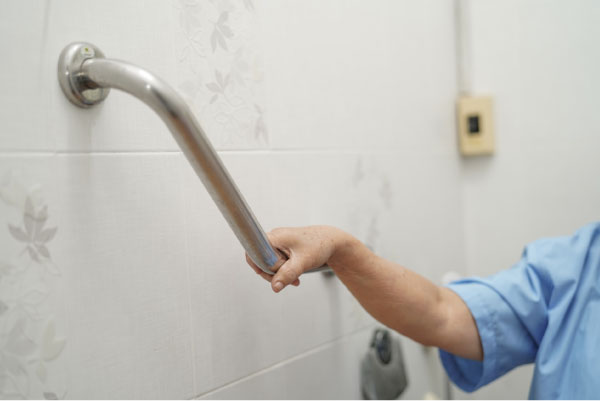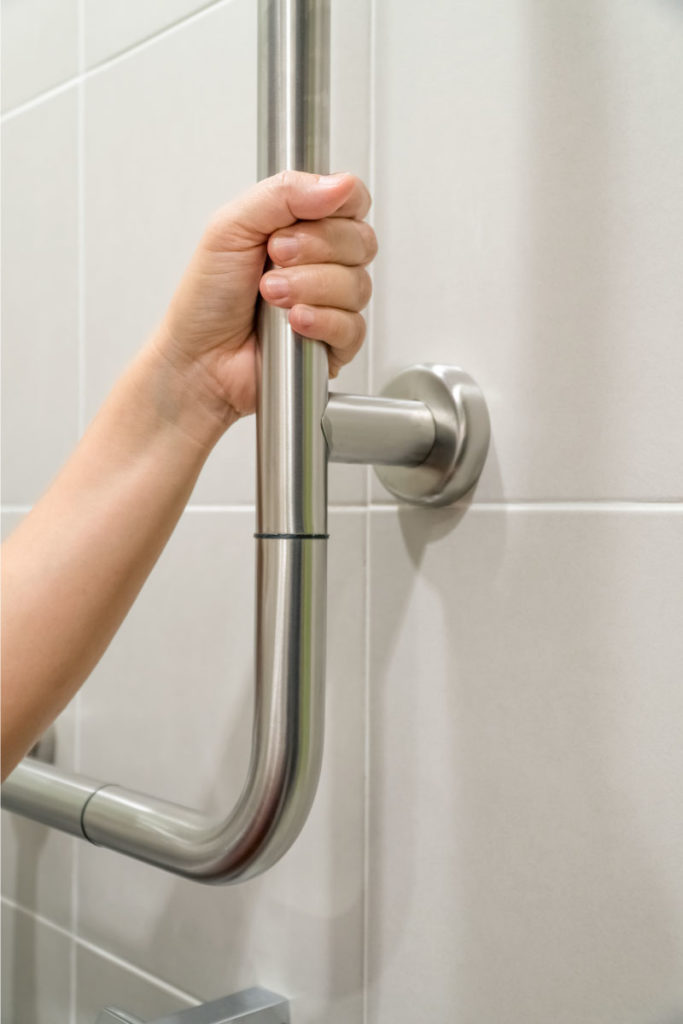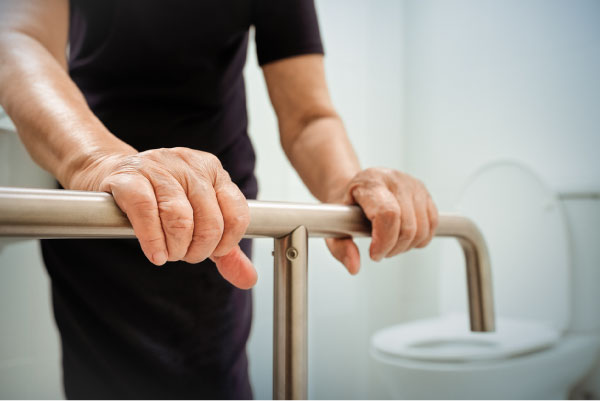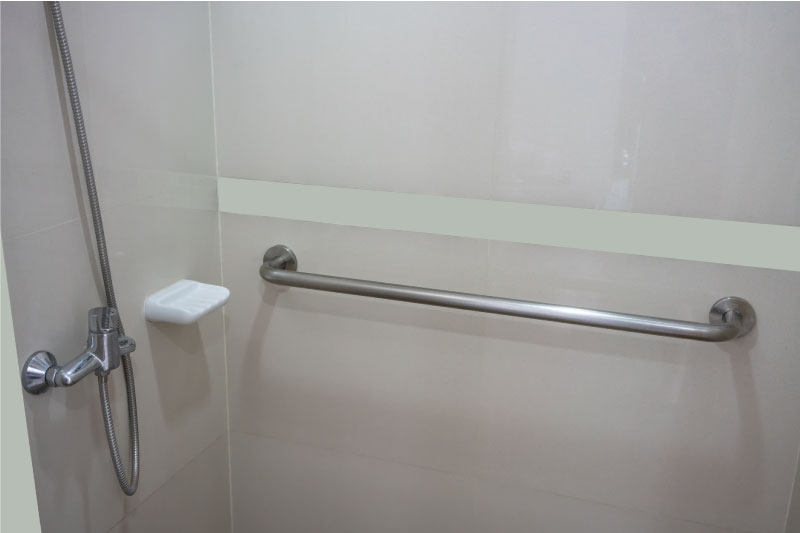
The vast majority of seniors want to age in place and live independently in their own homes. That means home safety must be a priority. Falls are the leading cause of injury among older adults, and many of these falls happen in the bathroom. Safety rails and grab bars installed in the shower/tub and toilet area can help prevent dangerous, even life-threatening, injuries.
Medicare usually doesn’t cover the purchase or installation costs for bathroom grab bars, safety rails, or other bathroom safety devices, but fortunately, these items are relatively inexpensive and easy to install without extensive remodeling.
Types of Bathroom Grab Bars and Safety Rails

- Straight grab bars: These come in a variety of lengths and finishes. They can be installed anywhere in the bathroom.
- Curved grab bars: Curved bars may have an “S” or wave shape that looks more stylish and less utilitarian than a basic, straight mode. Some people find them easier to use as well because the curved design can provide added stability in case of a fall.
- Multi-use safety bars: These provide the same secure support as straight and curved bars, but do double-duty. They may also have a towel bar or shelf for shampoo, soap, etc.
- Safety rails: These resemble stair handrails. Install them in areas where a longer bar is necessary. For example, a large bathroom may need a safety rail from the sink area to the tub/shower.
- Moveable grab bars: To conserve space in a small area, use moveable bars that fold flat against the wall until needed.
- Angled grab bars: These may be angled at 90 degrees for stability in a corner or slightly angled for areas where the surface is uneven.
All bathroom safety rails and grab bars need a rustproof finish, like high quality stainless steel.
Where to Place Grab Bars Around the Toilet

Many senior falls happen as they get up from the toilet. People at any age can get dizzy when they stand up quickly after sitting for a long time. Grab bars around the toilet can help the person steady herself if she feels lightheaded.
Ideally, you should place two grab bars on the wall beside (not behind) the toilet. A horizontal bar helps the user improve stability while sitting down or standing up. Place a vertical grab bar above it to provide support in case of lightheadedness after standing. Work with the user to what type of bar and which length/height and placement is most comfortable.
If the toilet isn’t near a wall, then consider installing a toilet frame that has arms on both sides. Alternatively, install a raised toilet seat or bedside commode placed over the toilet bowl. Those two options are often more comfortable for people with limited upper body strength.
Where to Place Shower Grab Bars and Safety Rails

It’s easy to fall in the shower or bathtub. The height of the average tub is about 18 inches, so stepping in and out can be tricky for someone with balance problems. That’s why many people install walk-in tubs for added bathroom safety. For some, even the 4-6 inch lip in a shower stall represents a challenge – particularly people using walkers or wheelchairs.
The exact placement depends on whether your bathroom contains a tub/shower combo or a shower stall. Both types should have a horizontal grab bar above the faucet to steady the user as they adjust temperature and water flow. In addition:
- Tub-only use: Install grab bars at elbow-height for easier entry and exit. Also, place a long grab bar 6-8 inches above the tub on the horizontal wall to help the user safely stand/sit in the tub. A U-shaped safety bar that clamps onto the side of the tub is a non-permanent way to improve safety.
- Shower-only: Place grab bars on either side of the shower entrance to aid in entering or exiting. Vertical grab bars should be at least 18 inches long, while horizontal bars should be at least 24 inches. Include at least one horizontal bar about waist height.
The exact height and placement depends on the size and needs of the primary user. It’s a good idea to always work with the person before you install grab bars and safety rails.
How to Install Bathroom Grab Bars
It’s critical that shower and toilet grab bars be firmly attached to the wall – preferably securely screwed into wall studs. Hollow wall anchors work on most plaster walls, but the safest installation method is screwing the bars directly into the wall studs. If you’re installing grab bars on ceramic tile, be sure to use a masonry bit to drill a small hole in the tile for the screw.
The easiest way to locate the studs in your walls is with a small tool called a “stud finder.”
- Slide it horizontally across the wall and listen for the beep that tells you the location of each stud.
- Mark the stud location lightly with a pencil and then measure the distance between the studs.
- Use that information to determine the best lengths for your grab bars.
Suction cup style grab bars can only be used on smooth surfaces, so be very careful about installing them on a tiled surface or painted wall. They have limited weight capacity. Most are for balance-assist only and not meant to support someone’s body weight. If you or your loved one can’t make any permanent adjustments to your bathroom (in a rental unit, for example), then the suction-style grab bars may be your only option. Just be aware of the limitations!
Let GetSafe Help You Stay Safe in the Bathroom
Shower and toilet grab bars are a great way to improve bathroom safety, but they are just one part of bathroom safety for seniors. Here are more bathroom makeover ideas to improve their safety:
- Walk-in tubs allow someone to walk into the tub enclosure or transfer into the tub from a wheelchair without climbing over a barrier.
- Shower chairs are portable, lightweight alternatives to a walk-in tub. They’re a good option for people who can’t make major home modifications or need a portable safety solution.
- Raised toilet seats come in a variety of styles and configurations. The make it easier for someone with mobility issues to use the toilet independently. Some styles can even be used as shower chairs.
- Wall-mounted help buttons that are either voice-activated or use a push button provide additional safety. In case of a fall or other emergency, you can quickly summon help.
GetSafe specializes in medical alerts that you don’t have to wear. When you place our voice-activated wall buttons throughout your home, help is just one call away! Contact us at 1-888-799-6255 to learn more.







